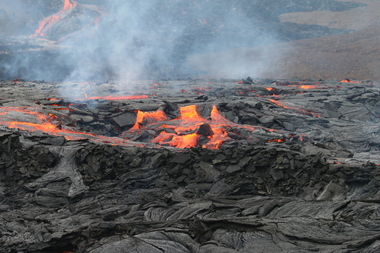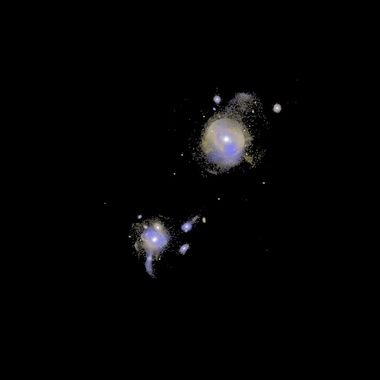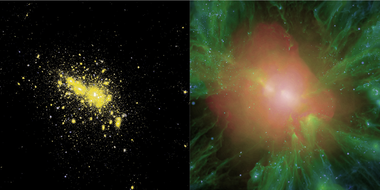Answer
By definition the Universe contains everything we know of, therefore it is the most colourful thing one could imagine!
We are only able to see some of these colours because we are located on planet Earth, which is close to the Sun, which is within our own Galaxy: the Milky Way. All three contain gases that absorb some types of light, blocking our ability to see all of the Universe at once, and thus also preventing us from detecting particular colours. To answer the question we will therefore assume that we are able to travel outside of the Milky Way into inter-galactic space, and then find out what colours our eyes would see.
First, we need to ask what a colour is, and how it is linked to light. The light we see is made up of waves that travel from an object to our eyes. Each wave has a particular amount of energy, and the energy of that wave is related to colour: the waves with the most energy that our eyes can see are purple, then blue, then green, followed by yellow, and finally red at the least energetic end. The mixture of waves that travel from an object to our eyes determines the colour we see. If all of the waves are energetic, it will appear purple or blue, if not energetic then red, and mixtures of waves can create new colours: red plus blue is magenta. When we add all of the colours together we see white. On the other hand, if there is no light at all, we will see black.

Fig. 1. Lava at the Geldingardalir eruption, April 2021. The molten lava glows in red light, but the cooled lava only reflects light, and very little light at that, and so appears black. |
Now we need to know how light is made, and why certain energies of light appear to come from different objects. We can make visible light by heating an object up to over several hundred degrees Celsius, which causes the object to start glowing. It will first glow in red light, and if we provide more heat the energy of the light will go up so we can start to make the object glow yellow or even blue. Once we have made light this way, it can be made to shine on a second object. Depending on what the second object is made of, it will absorb light that has some energies and reflect the rest. We detect the reflected light and interpret the total of all the waves reflected as the colour. If the object reflects all light we see white, and if it reflects very little light we see black. An example of this phenomenon is shown in Fig. 1, from the lava flow at Geldingardalir in April 2021. The lava flows out of the volcano hot enough to glow red, but quickly cools so that its colour comes from reflected sunlight, which it mostly absorbs and therefore to our eyes it is black or a very dark grey.
We can apply what we have learned about colour to our view of the Universe, as taken from our inter-galactic standpoint. Each galaxy is built out of many millions or billions of stars, where most light is generated. The colour of the stars is determined by their temperature, with the coolest stars glowing red — similarly to lava — and the hottest stars shining in blue light. Hot blue stars are much brighter than their cool red cousins but live for only a few million years before exploding as supernova, compared to a lifetime of many billions of years for red stars. Therefore, in places where many stars have been born within the last few million years the galaxy will be blue, and in older regions the galaxy will appear yellow or red.

Fig. 2. A simulation of our Milky Way galaxy (bottom left) and its companion, Andromeda (top right). Young stars are shown in blue and older stars in yellow. |
We can show this in simulations of galaxy formation. We programme a computer with the laws of nature to generate a pair of galaxies akin to our Milky Way and its companion, the Andromeda galaxy (Fig. 2). The dominant image colour is black, because most points in space do not contain matter that glows in, or reflects, light that we can see. We colour young stars in blue and old stars in yellow. We therefore show how different parts of galaxies have different colours.
Finally, throughout this article we have defined colour as the energy of light detected by our own eyes. Astrophysical objects can emit light at many more wavelengths than our eyes can detect, from very low energy radio waves right up to gamma rays. For example, in Fig. 3 we show two images of a computer-generated cluster of galaxies. One image is of the stars, and the second is of the hot gas. The temperature of gas in this cluster is 10 millionºC, over a thousand times hotter than lava, and glows in ‘invisible’ X-rays.

Fig. 3. A simulation of a massive cluster of galaxies. In the left hand panel we have the galaxies’ stars, and in the right hand panel we show the intergalactic gas. The colour of the gas is related to its temperature, with cold gas in green and very hot (X-ray emitting) gas in red. |
In conclusion, we have shown that the Universe is primarily black, if only because our eyes cannot detect light from between the stars, plus a mixture of blue, yellow and red.
Images:
- Figure 1: Image Credit: M. Lovell.
- Figure 2: Simulation Credit: M. Lovell et al. (DOI: 10.1093/mnras/staa2525). Image Credit: M. Lovell.
- Figure 3: Simulation Credit: Y. Bahé, D. Barnes et al. (DOI: 10.1093/mnras/stx1403, DOI: 10.1093/mnras/stx1647). Image Credit: M. Lovell.






